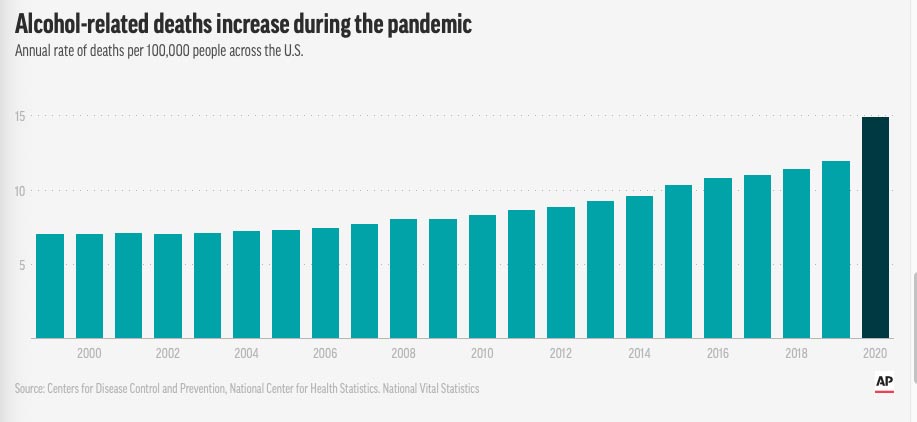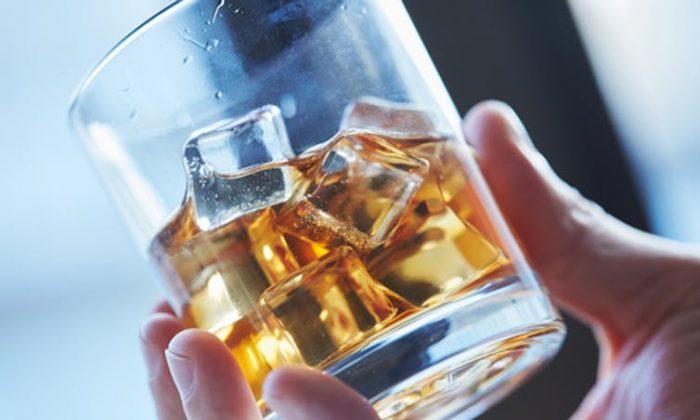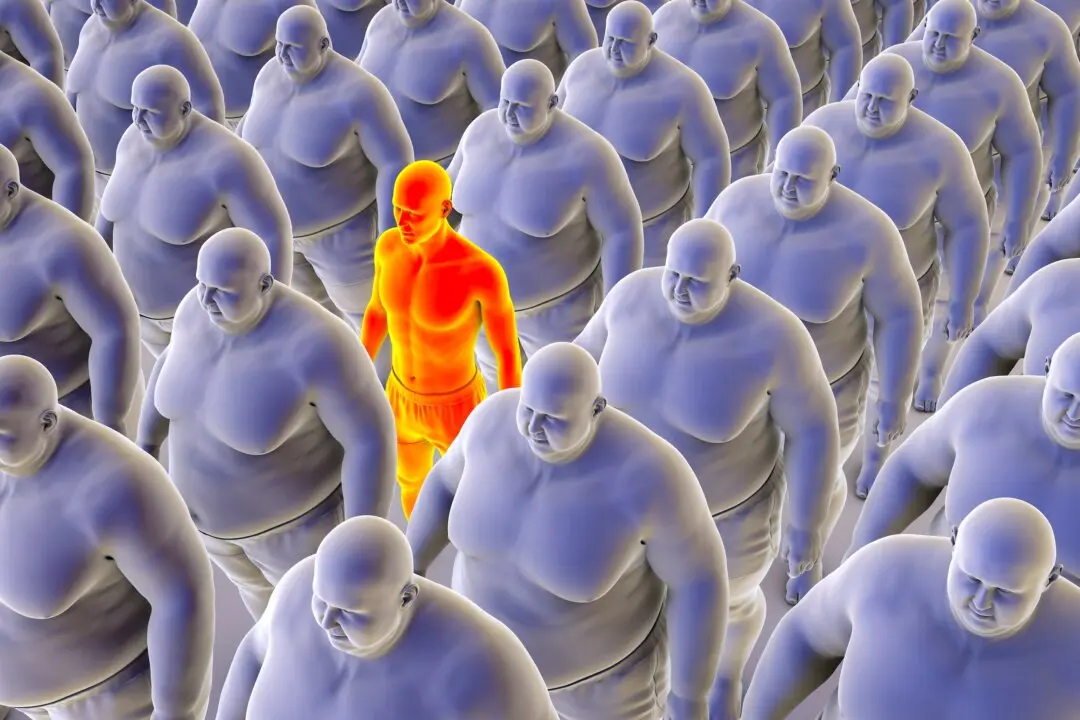And why weren’t they citing the soaring rates of this in 2020, instead of the number of COVID ‘cases’? It couldn’t be more clear that health officials did not have public health in mind when they declared these stores as ’essential' while shutting down this.
STORY AT-A-GLANCE
- Deaths attributed to excessive alcohol consumption in the U.S. are trending upward. Between 2015 and 2019, 1 in 5 deaths (20.3%) in the 20- to 49-year age group was related to excessive alcohol intake. The percentage of men dying from excess alcohol consumption (15%) was higher than that of women (9.4%), but both are on the rise
- Common types of alcohol-related deaths include alcohol poisoning, motor vehicle accidents, suicides, falls and alcohol-related liver disease or pancreas failure
- Other data from the U.S. Centers for Disease Control and Prevention suggest the rate of deaths directly attributed to alcohol rose by more than 25% in 2020, the first year of the pandemic, when many were self-isolating and working from home. The trend continued into 2021, by then up 34% from prepandemic levels
- Researchers have established a clear link between isolation, loneliness and alcohol abuse and addiction so, clearly, health officials did not have public health in mind when they declared liquor stores to be an “essential business” during the pandemic, while churches, gyms and even parks and beaches were shut down
- Two alcoholic drinks per day or less for men and one drink or less for women is considered “moderate” consumption. Binge drinking is defined as having five or more alcoholic drinks on a single occasion for men, or four or more for women. A “drink” is defined as 12 ounces of beer, 5 ounces of wine or 1.5 ounces of hard liquor
“The number of premature deaths could be reduced with increased implementation of evidenced-based, population-level alcohol policies, such as increasing alcohol taxes or regulating alcohol outlet density.”
Alcohol Intake Skyrocketed During Pandemic
Other data from the U.S. Centers for Disease Control and Prevention suggest the rate of deaths directly attributed to alcohol rose by more than 25% in 2020,4,5 the first year of the pandemic, when many were self-isolating and working from home. The trend continued into 2021, by then up 34% from prepandemic levels.6
Clear Links Between Loneliness and Alcohol Abuse
This should come as no surprise, seeing how researchers have long since established a clear link between isolation, loneliness and alcohol abuse and addiction. As noted in the 1992 scientific review “Loneliness and Alcohol Abuse: A Review of Evidences of an Interplay”:7Concordant reports demonstrate that alcoholics do feel more lonely than members of most other groups do. In advanced abusers, loneliness is obviously connected with a number of negative characteristics and, together with several of those, directly linked to a poor prognosis.
There are, however, no obvious relations to the external social situation (i.e. network) or amount of drinking. Instead, the feeling of loneliness appears to be more connected with a general negative perception about oneself and one’s relations to other people and also with a general dissatisfaction with most things in life ...”An even earlier study8 found “feeling of loneliness” was the most important factor influencing the prognosis of advanced alcohol abusers, followed by “a general dissatisfaction with the existing situation, independent of its nature.”
As noted by the authors, “To sum up, the lonely abuser showed a recurrent pattern characterized by discontentment and dissatisfaction, in combination with some traces of passivity in essential life-spheres.”
A Brief History of Alcohol
In the video above, podcast host Joe Rogan interviews university scholar and philosophy professor Edward Slingerland, Ph.D., author of “Drunk.” Slingerland highlights an important point, which is that, historically, mankind has not been drinking hard liquor.Traditionally, alcohol was primarily consumed in the form of beer with an alcohol content of 2% to 3%, and wine with an alcohol content of 8% to 10%. As noted by Slingerland, there’s a built-in limit to the amount of alcohol you can obtain through fermentation. Fermentation, as you likely know, is the process of yeast turning sugar in the brew into alcohol.
Over the past century or two, alcohol makers have developed hardier yeasts capable of fermentation rates as high as 16%. At present, that’s the upper limit for fermentation, as at that point, the alcohol shuts down the activity of the yeast.
Distillation, which is another modern invention, is a way around that. By heating the alcoholic beverage, you can capture the ethanol as a vapor and then turn it back into a liquid, giving you a really concentrated form of alcohol, i.e., distilled liquor or spirits, which can be as high as 90% alcohol by volume (ABV).
How Much Is Too Much?
According to experts, two alcoholic drinks per day or less for men and one drink or less for women is considered “moderate” consumption. Binge drinking is defined as having five or more alcoholic drinks on a single occasion for men, or four or more for women. A “drink” is defined as 12 ounces of beer, 5 ounces of wine or 1.5 ounces of hard liquor.Excessive Alcohol Intake Is a Primary Driver of Liver Damage
According to researchers, the rise in cirrhosis mortality is entirely driven by excess alcohol consumption by young adults. While, historically, alcohol-related liver cirrhosis has been regarded as a condition that develops after two or three decades of heavy drinking, these newer statistics reveal it doesn’t have to take that long at all, as it’s now occurring in (and killing) 20- and 30-year-olds.Limit Fructose to Protect and Heal Your Liver
While giving up the drink is a prerequisite, you’ll also want to strictly limit or eliminate fructose from your diet, the primary sources of which are sweet beverages like soda and most all processed foods and condiments.Fructose is metabolized differently in your body than glucose, resulting in the production of toxic byproducts (like uric acid) that are similar to those produced by the metabolism of alcohol, with similarly damaging effects on your liver.
There are clear data linking fructose consumption to causing your body to make fats — a disease process associated with nonalcoholic fatty liver disease (NAFLD) fat accumulation in the liver, which causes insulin resistance and associated diseases, such as Type 2 diabetes, hypertension, cardiovascular disease, cancer and dementia.
One of the best books ever written about the dangers of fructose is “The Sugar Fix” by Dr. Richard Johnson, a professor of medicine at the University of Colorado. A majority of Johnson’s work involves research, which primarily focuses on how fructose relates to obesity, high blood pressure, kidney disease and fatty liver disease.
Another leading expert in this area is Dr. Robert Lustig, professor of pediatric endocrinology at the University of California in San Francisco (USCF). His research shows sugar, in most forms, but fructose in particular, acts as a poison when consumed in excess.
Nutraceuticals That Support Liver Health
Aside from cutting out fructose and other forms of sugar, there are also nutritional supplements that can help protect and restore health and function to your liver, such as:How to Cut Down or Quit Drinking
If you’re not addicted but tend to drink more than what’s considered “moderate,” consider cutting down your consumption, or just quit cold turkey. Drink more water, including between drinks when socializing. If plain water gets old, get a Soda Stream and add some digestive bitters, fresh fruit or herbs.Help for Substance Use Disorders
If you live in the U.S. and need help or support for your alcohol addiction (or if you need support because a family member or friend has an addiction problem), contact the Substance Abuse and Mental Health Services Administration by calling 800-662-HELP (4357).21It’s a free, confidential helpline, available in English and Spanish, that’s open 24/7, every day of the year. They can offer acute help and provide treatment referrals to local treatment facilities, support groups and community-based organizations for individuals and family members facing mental and/or substance use disorders.
Sources and References
- 1 JAMA Network Open November 1, 2022; 5(11): e2239485
- 2 CNN November 2, 2022
- 3 JAMA Network Open November 1, 2022; 5(11): e2239485 Conclusions and Relevance
- 4, 6 CDC March 18, 2022
- 5 AP News November 4, 2022
- 7 Soc Sci Med February 1992; 34(4): 405-414
- 8 Scand J Soc Med 1987;15(3):175-83
- 9 Alcoholrehab.com May 18, 2022
- 10 American Journal of Public Health 2015 Jun;105(6):1120-7
- 11 World Population Review, Sugar Consumption in 2022
- 12 World Journal of Gastroenterology, 2010; 16(15): 1937
- 13 Indian Journal of Clinical Biochemistry 1994; 9(64)
- 14 Nutrients, 2018;10(4):440
- 15 Cancer, Epidemiology, Biomarkers and Prevention, 2007;16(6):1279
- 16, 18 Nutraingredients, July 19, 2008
- 17 Cancer Epidemiol Biomarkers Prev June 2007; 16(6): 1279-1282
- 19 The World’s Healthiest Foods, Folate
- 20 Journal of Natural Products, 2015; 78(8):1990
- 21 SAMHSA National Helpline






